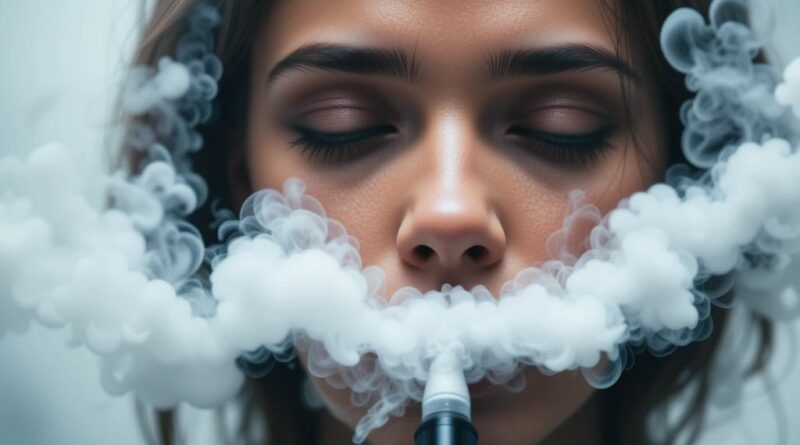The Hidden Dangers of Vaping: When Sweet Flavours Turn Deadly
How a teenager’s secret habit led to irreversible lung damage—and what every parent needs to know
The story sounds like something from a medical thriller: a seemingly healthy teenager develops severe breathing problems after secretly vaping for three years, eventually receiving a diagnosis that would change their life forever. The culprit? Bronchiolitis obliterans—also known as “popcorn lung”—a scarring of the tiny air sacs in the lungs resulting in the thickening and narrowing of the airways, according to the American Lung Association.
This isn’t just another cautionary tale about teenage rebellion. It’s a stark reminder that beneath the glossy marketing and appealing flavours of e-cigarettes lies a complex web of chemical compounds that can wreak havoc on developing lungs—often in ways we’re only beginning to understand.
The Sweet Deception: Why Teenagers Are Particularly Vulnerable
The vaping industry has masterfully crafted products that appeal to young people. With flavours ranging from cotton candy to tropical mango, these devices seem more like confectionery than medical devices. Yet this innocent appearance masks a troubling reality: current e-cigarette use among youth reached 1.63 million (5.9%) in 2024, according to the FDA’s National Youth Tobacco Survey.
The teen brain is still developing until around age 25, making it particularly susceptible to nicotine addiction. When combined with the direct pathway that vaping provides to the lungs and bloodstream, this creates a perfect storm for long-term health consequences. “Exposure to nicotine during adolescence can cause addiction and damage to the developing adolescent brain, lungs, and overall health,” warns New York State Health Commissioner Dr. James McDonald.
Understanding Popcorn Lung: The Science Behind the Scare
The term “popcorn lung” originated from cases of bronchiolitis obliterans observed in workers at popcorn factories who were exposed to diacetyl, a chemical used to create buttery flavouring. This condition makes it difficult to breathe, as explained by the Cleveland Clinic.
What makes this condition particularly insidious is its progressive nature. The disease gradually scars the smallest airways in the lungs—the bronchioles—leading to permanent damage that cannot be reversed. Symptoms include chronic coughing, wheezing, fatigue, and breathlessness that worsen over time.
While the direct link between vaping and popcorn lung remains scientifically debated, with no confirmed cases of popcorn lung linked to e-cigarettes according to Cancer Research UK, the concern stems from the complex chemistry of e-cigarette vapours.
The Chemical Cocktail: What’s Really in Your Vape?
E-cigarettes contain a sophisticated mixture of chemicals that undergo dramatic transformations when heated. The base liquid typically consists of propylene glycol, vegetable glycerine, nicotine, and flavouring agents. However, it’s what happens when these substances are heated that creates the real danger.
More than 180 different flavouring agents are used in e-liquids, many of which are classified as “generally recognised as safe” for consumption. The critical word here is “consumption”—meaning eating, not inhaling. When heated and inhaled, these same chemicals can become toxic compounds that directly damage lung tissue.
The process bypasses the body’s natural filtering systems. Unlike substances that are ingested and processed by the liver, inhaled chemicals from vaping reach the lungs and enter the bloodstream within seconds, distributing throughout the body without any protective mechanism.
Even as manufacturers have removed diacetyl from many products, substitute chemicals like acetoin and acetyl propionyl have raised similar concerns. These compounds can break down into diacetyl when heated, potentially creating the same risks through a different pathway.
Beyond Popcorn Lung: A Spectrum of Respiratory Dangers
The respiratory risks of vaping extend far beyond bronchiolitis obliterans. The specific effects of e-cigarettes on lung injury in teenagers included tachycardia, shortness of breath, and coughing, with six out of seven cases requiring ventilator support and hospitalisation, according to research published in npj Primary Care Respiratory Medicine.
The 2019 EVALI (E-cigarette or Vaping Product Use-Associated Lung Injury) outbreak demonstrated how quickly vaping-related lung injuries can escalate. Most cases were among teens and young adults, with symptoms starting gradually with shortness of breath and chest pain before severe breathing difficulty led to hospital admission, notes Harvard Health.
Research has also revealed that the odds of getting COVID were five times greater in teenage vapers, highlighting how vaping compromises the respiratory system’s ability to fight off infections.
The Inflammation Connection: How Vaping Damages Healthy Lungs
The mechanism by which vaping causes lung damage involves chronic inflammation. When foreign chemicals enter the delicate lung tissue, the body’s immune system responds with inflammation—a natural protective response that becomes problematic when sustained over time.
“This inflammation can eventually lead to scarring, airway blockage and permanent lung damage,” says Dr. Catalina Teba, a lung specialist at University Hospitals. “Although uncommon, for some people, popcorn lung can be life-threatening.” This insight, reported by University Hospitals, underscores the serious nature of vaping-related lung injuries.
The scarring process is irreversible. Once the tiny airways become damaged and scarred, they cannot return to their normal function. This means that even if a person stops vaping immediately after developing symptoms, the damage that has already occurred will persist for life.
The Regulatory Gap: Why Current Oversight Falls Short
One of the most concerning aspects of the vaping industry is the lack of comprehensive regulation regarding the hundreds of chemicals used in e-liquids. While traditional cigarettes have been extensively studied over decades, e-cigarettes represent a relatively new frontier in tobacco harm research.
The FDA has begun implementing stricter oversight of e-cigarette products, with focused compliance and enforcement actions against unauthorised products like Elf Bar, as reported by the CDC. However, the rapid pace of product innovation often outstrips regulatory response.
Current labelling requirements don’t adequately inform consumers about the potential for chemical transformation when e-liquids are heated. Many users remain unaware that substances safe for consumption can become toxic when inhaled, particularly after repeated heating cycles.
The Teen Brain Factor: Why Adolescents Face Unique Risks
Adolescent brains are still developing, particularly the prefrontal cortex responsible for decision-making and risk assessment. This biological reality makes teenagers particularly vulnerable to both nicotine addiction and the tendency to dismiss long-term health consequences.
Teens and young adults who vape are at a higher risk of asthma exacerbations and developing asthma, according to research cited by EssayHub. For those with pre-existing respiratory conditions, vaping can trigger severe complications that require immediate medical intervention.
The social aspect of vaping among teenagers also creates additional risks. Secret vaping, as seen in the popcorn lung case, means that symptoms may go unrecognised for extended periods, allowing damage to progress unchecked.
Early Warning Signs: Recognising Respiratory Distress
Parents, educators, and healthcare providers need to be aware of the early warning signs of vaping-related lung injury. Initial symptoms can be subtle and easily dismissed as minor respiratory irritation:
Persistent coughing, especially a dry cough that doesn’t resolve, can be an early indicator of airway irritation. Shortness of breath during normal activities that wouldn’t typically cause breathing difficulties is another red flag. Chest tightness or pain, particularly when breathing deeply, should prompt immediate medical attention.
Fatigue that seems disproportionate to activity levels can indicate that the lungs aren’t efficiently oxygenating the blood. Wheezing or whistling sounds when breathing, especially during exhalation, suggest airway narrowing that requires professional evaluation.
The Path Forward: Prevention and Early Intervention
The most effective strategy remains prevention through education and awareness. Young people need to understand that the apparent safety of vaping is largely an illusion created by marketing rather than scientific evidence.
Healthcare providers recommend complete cessation of vaping for anyone experiencing respiratory symptoms. Unlike some forms of lung damage, catching vaping-related injuries early can prevent progression to more severe, irreversible conditions.
For those struggling with nicotine addiction from vaping, numerous resources are available, including the CDC’s tips for quitting smoking and vaping, counselling services, and nicotine replacement therapies designed specifically for young people.
The Bigger Picture: A Public Health Crisis in the Making
The emergence of vaping-related lung injuries represents more than isolated medical cases—it signals a potential public health crisis that could affect an entire generation. About 90 percent of participants in recent studies have had pediatric acute respiratory distress syndrome (PARDS), a rapidly progressing disease that causes fluid to leak into the lungs, according to Children’s Hospital Los Angeles.
The long-term consequences of widespread youth vaping remain largely unknown, but early indicators suggest we may be witnessing the beginning of a wave of respiratory diseases that will burden healthcare systems for decades to come.
Taking Action: What Parents and Communities Can Do
Prevention requires a multi-pronged approach involving parents, schools, healthcare providers, and policymakers. Open, honest conversations about vaping risks—based on scientific evidence rather than scare tactics—are most effective with teenagers.
Schools need comprehensive education programmes that address not just the health risks but also the sophisticated marketing techniques used by vaping companies to target young people. Healthcare providers should routinely screen for vaping use and provide resources for cessation.
Policymakers must strengthen regulations around e-cigarette marketing, particularly flavoured products that appeal to minors, and ensure that health warnings accurately reflect the current understanding of vaping risks.
Conclusion: The Cost of Sweet Temptation
The teenager who developed popcorn lung after three years of secret vaping serves as a powerful reminder that the consequences of seemingly harmless choices can be profound and permanent. Their story illustrates how the appealing facade of modern e-cigarettes can mask serious health risks that we’re only beginning to understand.
As research continues to unveil the complex ways in which vaping affects respiratory health, one thing remains clear: the sweet flavours and sleek designs that make these products attractive to young people can come at a devastating cost. The lungs scarred by bronchiolitis obliterans will never fully heal, serving as a permanent reminder that in the world of vaping, what appears harmless can be anything but.
The choice to vape may seem like a personal decision, but its consequences extend far beyond the individual. As we grapple with rising rates of youth vaping and emerging cases of serious lung injury, the message is becoming increasingly urgent: when it comes to protecting our lungs, the safest choice is not to vape at all.
We’d love your questions or comments on today’s topic!
For more articles like this one, click here.
Thought for the day:
“When you forgive, you in no way change the past – but you sure do change the future.” Bernard Meltzer



